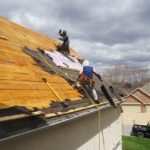After a severe storm with hail, it’s essential to assess the condition of your roof for any potential damage. Hail can wreak havoc on roofs, leading to leaks and other costly issues if left unnoticed.
In this article, we will guide you on safely identifying roof hail damage and the immediate steps you should take to address the situation. By following these essential tips, you can protect your home and ensure the longevity of your roof.
Understanding Roof Hail Damage
Hail damage to roofs can vary in severity depending on the size and intensity of the hailstones. It’s crucial to note that it may not always be immediately visible, so a thorough inspection is necessary.
Here are some common signs to look out for.
Dented or Cracked Shingles
Inspect your shingles for any dents or cracks. Hail impact can cause shingles to lose their protective granules or even crack. This will compromise their integrity.
Dislodged or Missing Shingles
Hail can dislodge shingles, causing them to shift or go missing altogether. Look for any noticeable gaps or areas where shingles are no longer in place.
Bruised or Split Wood Shingles
If you have a wood shingle roof, check for signs of bruising or splitting caused by hail impact. These shingles may appear dented or have visible cracks.
Damaged Gutters and Downspouts
Hail can also cause damage to your gutters and downspouts. Look for dents, cracks, or sections that have become loose or detached.
Taking Immediate Action
Once you’ve identified roof hail damage, taking immediate action is crucial to prevent further issues and protect your home. Here are the steps you should follow.
Document the Damage
Take clear photographs of the roof damage as evidence for insurance claims and future reference. Make sure to capture close-up shots that clearly show the extent of the damage.
Contact Your Insurance Provider
Notify your homeowner’s insurance provider about the hail damage immediately. They will guide you through the claims process and explain the next steps.
Consult a Professional Roofing Contractor
It’s advisable to contact a reputable roofing contractor experienced in roof damage repairs. They can conduct a detailed inspection, provide a professional assessment, and recommend repairs or replacements.
Temporary Repairs
In some cases, a temporary roof repair may be necessary to prevent further damage before a permanent fix can be implemented. Consult with your roofing contractor about applying temporary patches or covers to minimize leaks and further deterioration.
Preventing Future Hail Damage
While it’s impossible to control the weather, there are measures you can take to minimize the impact of hail on your roof:
Install Impact-Resistant Roofing Materials
Consider using impact-resistant shingles or roofing materials specifically designed to withstand roof damage. These materials have undergone rigorous testing and are more resilient against hail impact.
Contact professionals for this, and you may check this page for metal roofing installation needs.
Regular Roof Inspections
Schedule routine inspections by a professional roofing contractor to catch any early signs of damage or vulnerability. Prompt repairs or maintenance can prevent minor issues from escalating into major problems.
Keeping Your Roof Safe
Identifying and addressing roof hail damage promptly is crucial to protect your home and prevent further deterioration. By understanding the signs of hail damage and taking immediate action, you can ensure the safety and longevity of your roof.
By following these essential tips, you can effectively navigate the aftermath of a hailstorm and safeguard your home for years to come.
If you found this article helpful, explore our other blog posts!




